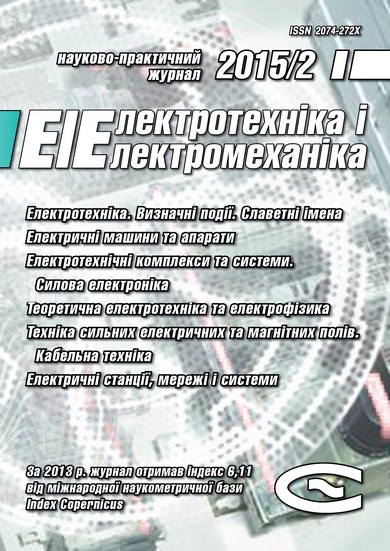FORMING CAPABILITIES OF A PULSE MAGNETIC FIELD GENERATOR
DOI:
https://doi.org/10.20998/2074-272X.2015.2.13Keywords:
pulses generator, magnetic field, pulse form, element parametersAbstract
Purpose. Determination of areas ratio of the parameters of the discharge circuit elements of the generator, which ensure the formation of magnetic field pulses of different shapes. Methodology. Numerical simulation using dimensionless variables that determine the nature of the transition process in the discharge circuit of the generator, and use the procedure for determining the pulse points of meeting the conditions of extremum and the transition through zero. Results. Obtained a description of the formation of the three specific areas of waveforms: oscillatory weakly damped oscillatory strongly damped and unipolar pulse with a monotonic rise and fall values. A relation to the choice of parameters of elements of the discharge circuit of the generator, which formed unipolar pulses with a monotonic rise and fall values. Originality. A completed and extended database that implements the mapping of the formal description of the pulse shape with a description of areas ratio parameters for high-voltage pulse discharge circuit test units, with respect to the pulses of current flowing in the formation of the magnetic field. Practical value. The relations obtained allow to select the parameters of the discharge circuit elements of the generator designed to generate test pulses of magnetic field.References
GOST 30336-95. Sovmestimost' tekhnicheskikh sredstv elektromagnitnaia. Ustoichivost' k impul'snomu magnitnomu poliu. Tekhnicheskie trebovaniia i metody ispytanii [State Standard 30336-95. Compatibility of technical equipment. Resistance to pulse magnetic field. Technical requirements and test methods]. Moscow, Izdatel'stvo standartov Publ., 2001. 12 p. (Rus).
Myrova L.O. Chepizhenko A.Z. Obespechenie stoykosti apparatury svyazi k ioniziruyuschim i elektromagnitnym izlucheniyam [Ensuring the stability of communications equipment to ionizing and electromagnetic radiation]. Moscow, Radio and communications Publ., 1988. 296 p. (Rus).
Kravchenko V.I. Grozozaschita radioelektronnyh sredstv: Spravochnik [Lightning protection of radio electronic means: Directory]. Moscow, Radio and communications Publ., 1991. 264 p. (Rus).
Kravchenko V.I., Koliushko G.M., Petkov A.A. Interconnection structure of high impulse device and forms generated pulses. Fizika impulsnyh razryadov v kondensirovannyh sredah: mezhdunar. nauch. konf., 17-21 avgusta 2009 g.: tezisy dokl. [Physics of pulsed discharges in condensed media: Intern. scientific. Conf., 17-21 August 2009: Abstracts]. Nikolaev, 2009,
pp. 119-120. (Rus).
Petkov A.A. The generation of test pulses of magnetic field. Visnyk NTU "KhPІ" – Bulletin of NTU "KhPІ", 2006, no.37,
pp. 73-78. (Rus).
Korn G., Korn T. Spravochnik po matematike dlya nauchnyh rabotnikov i inzhenerov [Mathematical Handbook for Scientists and Engineers]. Saint Petersburg, Lan’ Publ., 2003. 832 p. (Rus).
Kravchenko V.I., Petkov A.A. Parametrical synthesis of high-voltage pulse test devices with capacitive energy storage. Elektrotekhnіka і elektromekhanіka – Electrical engineering & electromechanics, 2007, no.6, pp. 70-75. (Rus).
Downloads
Published
How to Cite
Issue
Section
License
Copyright (c) 2015 A. A. Petkov

This work is licensed under a Creative Commons Attribution-NonCommercial 4.0 International License.
Authors who publish with this journal agree to the following terms:
1. Authors retain copyright and grant the journal right of first publication with the work simultaneously licensed under a Creative Commons Attribution License that allows others to share the work with an acknowledgement of the work's authorship and initial publication in this journal.
2. Authors are able to enter into separate, additional contractual arrangements for the non-exclusive distribution of the journal's published version of the work (e.g., post it to an institutional repository or publish it in a book), with an acknowledgement of its initial publication in this journal.
3. Authors are permitted and encouraged to post their work online (e.g., in institutional repositories or on their website) prior to and during the submission process, as it can lead to productive exchanges, as well as earlier and greater citation of published work.





